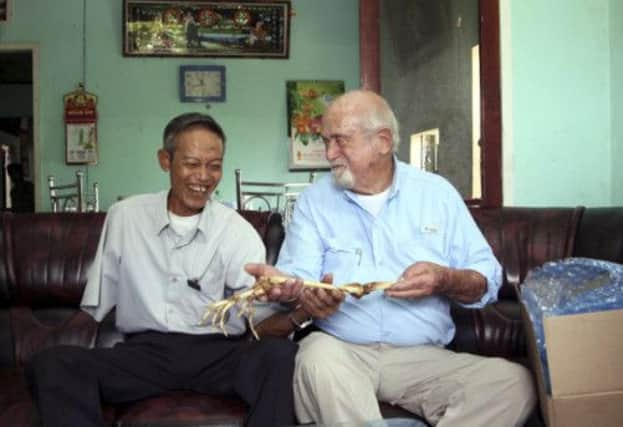US doctor returns grim souvenir to Vietnam


Texas doctor Sam Axelrad, then 27, operated on a badly injured North Vietnamese soldier in 1966. Following the procedure, his colleagues boiled off the flesh, reconstructed the arm bones and gave them to him as a reminder of the good deed.
The bones sat in a military bag in Dr Axelrad’s cupboard for decades, along with other things from the war that he didn’t want look at because he didn’t want to relive those experiences.
Advertisement
Hide AdAdvertisement
Hide AdWhen he finally went through the mementos in 2011, “it just blew me away what was in there,” Dr Axelrad said. He then set about trying to trace the soldier he treated, Nguyen Quang Hung, who had been shot in an ambush by US troops.
A chance meeting with a Vietnamese journalist in Hanoi led to an article in a Vietnamese newspaper about Dr Axelrad’s quest to return the bones to their owner. Mr Hung, now 73, said his brother-in-law in Ho Chi Minh City read the article and contacted the newspaper’s editors.
The men were reunited yesterday at Mr Hung’s home in central Vietnam. They met each other’s children and grandchildren, and joked about which of them had been better looking back when war had made them enemies.
Mr Hung was stunned that someone had kept his bones for so long, but happy that when the time comes, they will be buried with him.
“I’m very glad to see him again and have that part of my body back after nearly half a century,” Mr Hung said.
“I’m proud to have shed my blood for my country’s reunification, and I consider myself very lucky compared with many of my comrades who were killed or remain unaccounted for.”
Mr Hung said American troops shot him in the arm in October 1966 during an ambush about 50 miles from An Khe, the town where he now lives. After floating down a stream to escape the firefight and then sheltering in a rice warehouse for three days, he was evacuated by a US helicopter to a no-frills military hospital in Phu Cat, in central Binh Dinh province.
“When I was captured by the American forces, I was like a fish on a chopping-board,” Mr Hung said. “They could have either killed or spared me.”
Advertisement
Hide AdAdvertisement
Hide AdWhen Mr Hung got to Dr Axelrad, his right forearm was the colour of an aubergine, according to the doctor. To keep the infection from killing his patient, Dr Axelrad amputated the arm above the elbow.
After the surgery, Mr Hung spent eight months recovering and another six assisting American military doctors, he said. He spent the rest of the war offering private medical services in the town, and later served in local government before retiring.
“He probably thought we were going to put him in some prisoner-of-war camp,” Dr Axelrad said.
“He was totally surprised when we just took care of him.”
Mr Hung yesterday served Dr Axelrad and his family lunch, shared memories and reflected on all the time that had passed.
Dr Axelrad said he was pleased to learn where and how Mr Hung had been living for so many years, and to meet his children and grandchildren.
“I’m so happy that he was able to make a life for himself,” Dr Axelrad, who is now a urologist in Houston, said.
Vietnam is now a country full of young people who have no direct memory of the war, which ended in 1975 and killed an estimated 58,000 Americans and three million Vietnamese. But the war’s legacy persists in the minds of combat veterans who still are processing the events and traumas they witnessed in their youth.
John Ernst, a Vietnam War expert at Morehead State University in Kentucky, said he knows of a few American veterans who have travelled to Vietnam to return personal items to former enemy soldiers as a way to bring closure.
“It is a fascinating phenomenon,” Mr Ernst said. “I always wonder what triggers the decision to make the gesture.”